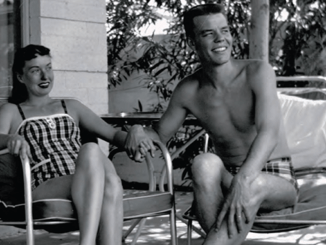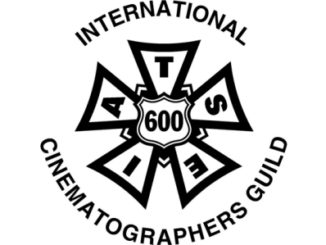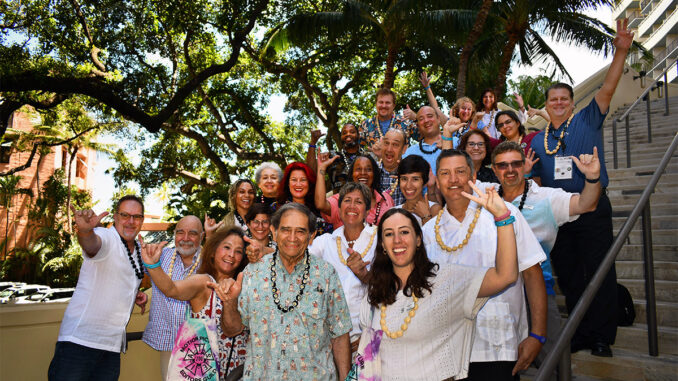
By A.J. Catoline
It was a working vacation in Honolulu for the elected delegates of the Editors Guild. Some parts sand and sun, and the rest solidarity.
Yet even on the warm and idyllic shores of Oahu, IATSE convention-goers could not escape thoughts about a hotter summer of Hollywood labor unrest and a lack of jobs back home.
The 79th annual District 2 Convention of the International Alliance of Theatrical Stage Employees (IATSE) convened June 10 at the Sheraton Waikiki.
The Guild sent 23 delegates — elected by the general membership every four years — including National Executive Director Cathy Repola, President Alan Heim and Western Director Scott George.
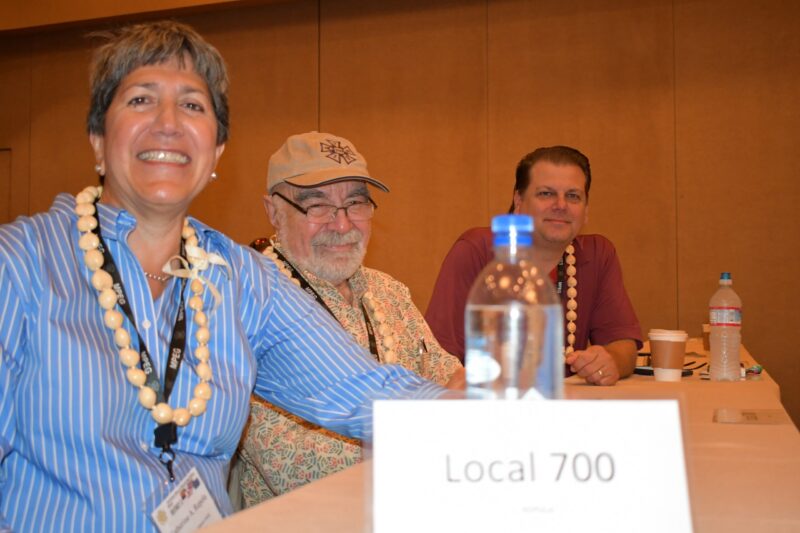
The large group of delegates spent the weekend connecting with fellow IATSE brothers, sisters and kin — especially among other locals in the Hollywood film and television bargaining group — across the region of California, Nevada, Arizona and Hawaii. The convention site rotates each year and in 2024 will go to Lake Tahoe, Calif.
International Vice-President and District 2 Co-Chair Mike Miller gaveled open the convention on a note of compassion to union members still recovering from production shutdowns following the Covid pandemic, and now struggling with work stoppage due to the Writers Guild of America (WGA) strike, which began May 1.
“It is an AMPTP-led strike to be clear,” said Miller to resounding applause, referring to the motion picture producers’ bargaining group, which has not made a fair labor deal with film and TV writers. “The purpose of our union has never been more important and more relevant to our members than it is right now,” Miller continued.
International President Matt Loeb reiterated the commitment of the IATSE to stand in solidarity with the WGA. “It’s not our fight directly, but nobody wants to see a union get beat,” said Loeb. The strike is “creating unity throughout the unions,” Loeb said. “We have to stay strong together to win, all of us.”
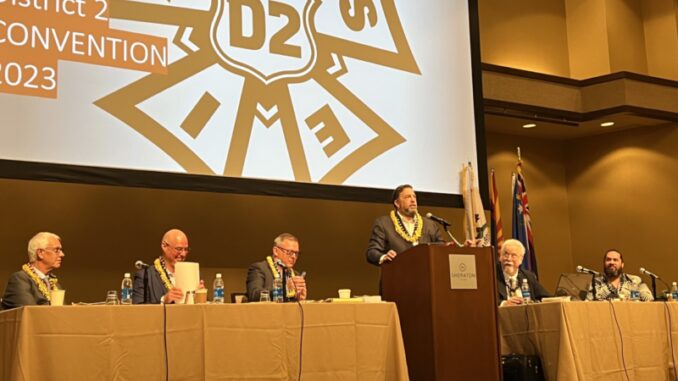
Union members are increasingly concerned with the evolving use of Artificial Intelligence technology in the workplace. Loeb urged members to stay on the forefront of technology, as IATSE has done since the union was founded in 1893, adding that a commission has been formed to look in to protecting each local and the crafts they cover.
“We have to make the tools of the future our tools,” said Loeb. “We have to protect our jurisdiction, we have to protect our jobs, and we have to train people into the future to make sure the IATSE holds its rightful place in the industry.”
Loeb also reported that the first IATSE member census, as mandated by the last quadrennial convention, will be electronically distributed to members on July 10. The goal is to determine demographics of active union members across the country and Canada.
Miller said the District 2 convention is “the penultimate inter-local meeting” for elected delegates across all crafts and the region to come together to “talk about issues that we share” and to “bring our struggles together to find equitable solutions.”
Five resolutions came to the floor in support of women, mothers and persons in the workplace, urging comprehensive benefits including fertility, adoption and advance arrangements for expression of breast milk. All were passed unanimously.
Delegate Andy Garner-Flexner of Local 839 Animation Guild passionately spoke in favor of his local’s resolution for District 2 to expressly support human rights for LGBTQIA+ members and to review union health insurance plans to expand coverage for medical care and procedures for transgender members. Both passed with resounding unanimous consent.
However, a resolution to investigate vote-counting procedures during conventions was hotly debated and failed in a series of close and contentious votes.

Away from the convention floor, Local 700 delegates mingled with members in sister locals in the Hollywood bargaining group. There were many conversations about next year’s negotiation for the IATSE Basic Agreement, which covers about 45,000 members working in film and television.
“If our members stay united, we will show our strength and can achieve our common goals,” said Cathy Repola. “The IATSE will be sending a survey to members in September asking them to rank their priorities of what contract conditions they most want to improve. It is critical we have full participation in this survey. This data will represent the voice of our members and what they are eager to fight for next year.”
Evidently, there is common ground among members to achieve significant increases to scale wages and secure more funding for the health and pension plans.
The IATSE Women’s Committee gathered for a mixer, handing out slips of paper with written questions to each delegate, such as “when did you feel most powerful?” And “What was the toughest challenge you faced in your career?” Nearly $1500 was raised for Women Helping Women (womenhelpingwomen.org).
The Memorial Committee celebrated members dearly departed, and Local 700 delegates reported 110 Editors Guild members from several classifications passed away in the year since the prior convention. There was special recognition for Donn Cambern, ACE, a legendary former Editors Guild president and cherished mentor, and Oscar-nominated editor of “Easy Rider.” Also mentioned was “Avatar” editor John Refoua, ACE.
A lively convention moment came during debate on a resolution to reform the district’s voting procedures so that votes from delegates in attendance are more proportional to the members they represent.
When votes are counted among IATSE locals, whether at a convention or when ratifying a contract, the counting mechanism is similar to the U.S. electoral college. Each local has a number of electoral votes relative to the size of their membership.

For District 2, Local 700 currently has a roster of 76 votes, and that many elected delegates could be eligible to attend an IATSE convention. That is apprised of the total number of members within reside in California, Hawaii, Nevada and Arizona. The Board of Directors determines the actual number delegates to send to conventions, and therefore some are allotted extra votes. Editors Guild delegates at this year’s convention represented anywhere from 2-5 votes each, whereas other delegates may only have a single vote if their local has a smaller membership.
Since most votes on the convention floor are done by voice — a call for “yay” or “nay” — it is not immediately apparent how many electoral votes are being represented.
The resolution proposed by Hollywood Local 728, set lighting technicians, asked the District to “investigate the use of alternate voting procedures for future conventions in order to ensure fair representation of all of its delegates.”
The resolution initially failed to be recommended by the Resolutions Committee, where opposition said it favored the voting power of larger locals at the expense of locals with fewer members. Co-Chair Miller informed the convention that there were 231 accredited delegates in attendance who represented a total of 551 electoral votes across the district, with the top five locals controlling at least two-thirds of the votes.
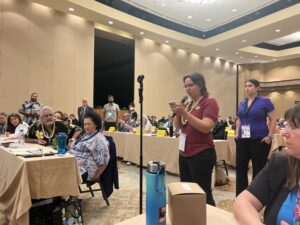
Nonetheless several delegates persisted to speak up for the resolution on the floor. “My badge here says five votes,” said Picture Editor and Board Member Shiran Carolyn Amir, referring to the delegate credential lanyard. “I represent 500 people, so when I say ‘yay’ or ‘nay’ with my one voice, 400 people are not getting representation. Between all delegates here, thousands of members lose their fair representation. An inaccurate voting system erodes confidence… in the core concept of a democratic process.”
Picture Editor Wilbur DiTullio advocated that smaller locals “without deep pockets” are already under-represented with fewer delegates than their allotment in the room. She added some classifications fighting for pay equity may not be able to front the costs of attending with their full slate of delegates.
The resolution failed on a voice vote. A division of the house was moved, and more delegates stood opposed than in favor. A roll call vote was moved, which would have counted actual electoral votes, and the motion again failed on both a voice and division vote.
At the close of convention business, Co-Chair Miller implored the delegates that despite passionate debate and disagreement, they must leave the hall united in their common goals.
On Saturday night, the traditional Luau celebration brought the full convention together in the spirit of “aloha and mahalo” on the lawn of the Royal Hawaiian Hotel with local themed food and cocktails. It was sponsored by the host locals, including Locals 600 and 700, and Hawaii production Local 665. It was a festive end to a long convention day, as Editors Guild delegates were seen being lively on the grass dance floor fronting Waikiki Beach.

Board Member Molly Shock shared some photos on social media. “I could post a photo of how we have been spending MOST of our time, sitting in a large room listening to IATSE proposals or discussing the important issues we are facing as a union,” Shock wrote. “OR I can post this picture of me leading a conga lines with some of our wonderful MPEG700 leaders, who I am lucky enough to call friends.”
Other members of the Local 700 delegation included Shiran Carolyn Amir, Erik Andersen, Lillian Benson, A.J. Catoline, Elisa Cohen, Frank Delgado, Wilbur DiTullio, Jesse Dodd, Emma DuPell, Sargeant-at-Arms Bill Elias, Nancy Frazen, Leah Gunter, Former National Executive Director Ron Kutak, Stephanie Lowry, Vice President F. Hudson Miller, Nancy Morrison, Paul Overacker, Kevin Ross, Molly Shock, Isabel Yanes and Michael Zurer.


